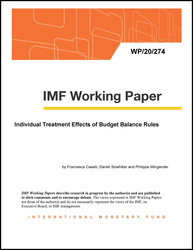
Individual Treatment Effects of Budget Balance Rules
Individual Treatment Effects of Budget Balance Rules
READ MORE...
Volume/Issue:
Volume 2020
Issue 274
Publication date: December 2020
ISBN: 9781513563855
$20.00
Add to Cart by clicking price of the language and format you'd like to purchase
Available Languages and Formats
| English |
Prices in red indicate formats that are not yet available but are forthcoming.
Topics covered in this book
This title contains information about the following subjects.
Click on a subject if you would like to see other titles with the same subjects.
Economics- Macroeconomics , Public Finance , fiscal policy , heterogeneous treatment effects , synthetic control , difference-in-differences , WP , treatment effect , budget balance rule , donor country , balance rule , distribution of treatment effect , effects from the baseline SDD specification , effects from the SDD specification , treatment effects from the SDD analysis , treatment fit
Summary
This paper investigates the heterogenous effects of budget balance rules on fiscal policy in a large sample of countries. To derive country-specific treatment effects of fiscal rules and conduct inference, we use a Synthetic Difference-in-Differences Method. Our results indicate that countries with a budget balance rule improve their fiscal balance on average by around 3 percent after its introduction. However, our results also illustrate the importance of going beyond the average treatment effect, as it masks significant heterogeneity in the country-specific impact of the rule. We find that countries that would have had large deficits in the absence of the fiscal rule exhibit positive treatment effects, thus reducing their budget deficits. On the other hand, countries with budget surpluses respond to fiscal rules by reducing their budget surplus and moving closer to the numerical target of the rule. Our results also suggest that rules’ design matters: a small overall number of fiscal rules, and the presence of a monitoring process outside the government, especially at the supra-national level, improve significantly the effectiveness of the rules.
Copyright © 2010 - 2025
Powered by:
AIDC



